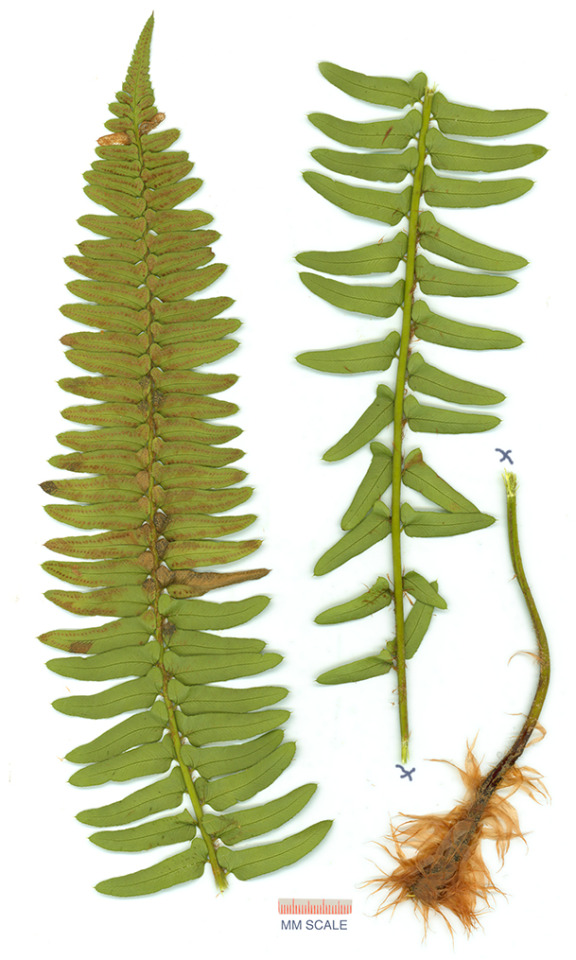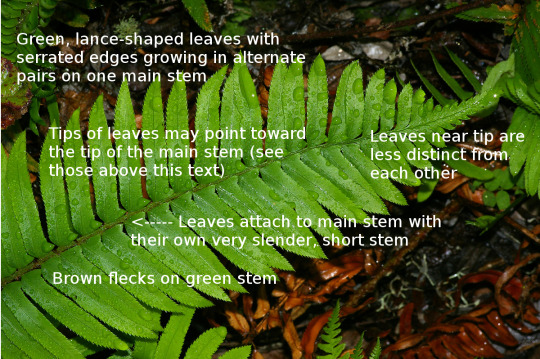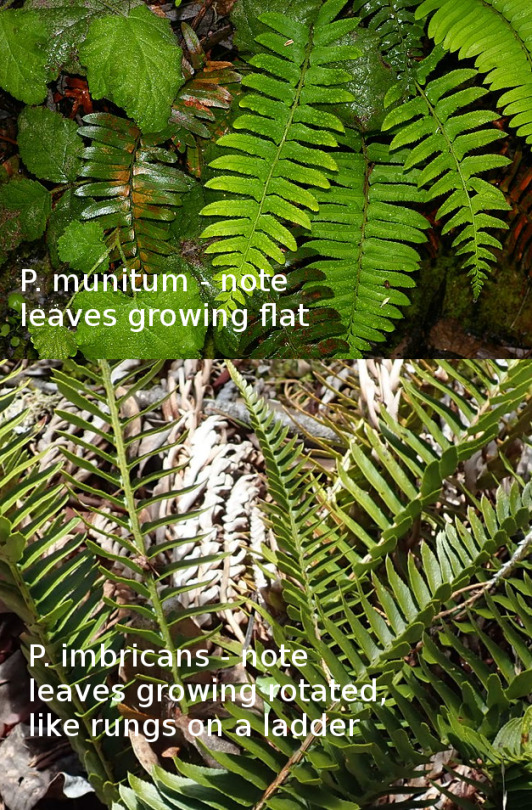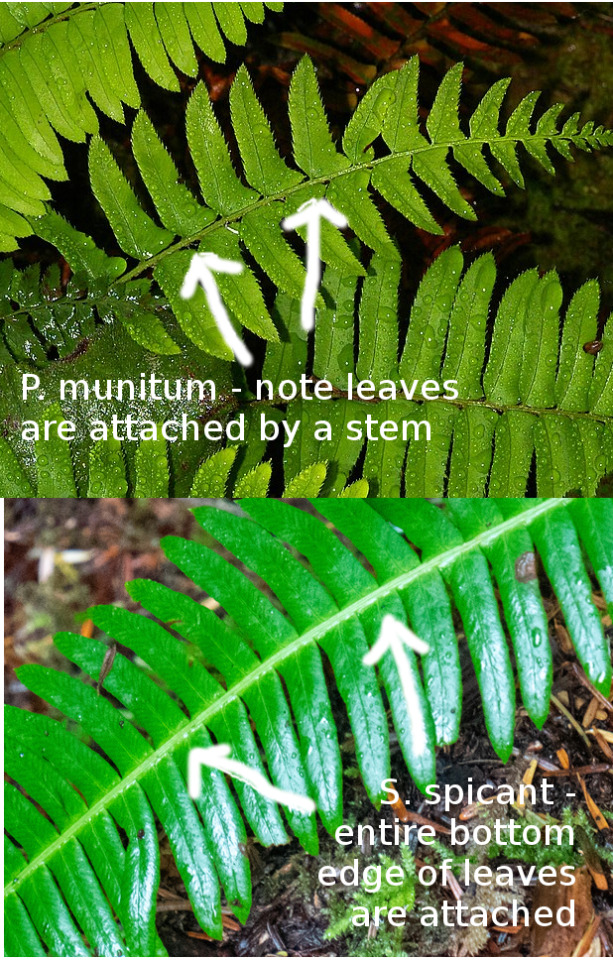#Polystichum imbricans
Text
Polystichum imbricans, Narrowleaf Sword Fern
Polystichum imbricans, Narrowleaf Sword Fern
perennial fern


KEY
terrestrial plant with no flowers or bulbs sporangia present
Herbs reproducing by spores released directly from sporangia, the sporangia variously located [on abaxial leaf face, [LYCOPHYTES and FERNS]
Plant terrestrial l; leaf 1-2 pinnate,; sporangia borne on aerial portion of leaf
Leaves all alike or nearly so, the fertile [sporangium-bearing] blades very similar in size and shape to sterile blades sporangia borne on underside of leaf blade, new leaves generally coiled, unrolling as they develop
Sori borne away from margin on underside of leaf or leaflet, sporangia clustered in distinct sori; indusia present
Sori ± round
Blade without needle-like hairs
Indusium peltate or round-reniform, attached ± in center of sorus , generally present and readily observable in late-season specimens ..... DRYOPTERIDACEAE
- Indusium peltate , centrally attached, without a sinus
- Veins generally free, rarely ± joined; leaf 1–3-pinnate, teeth, generally including bristle-like tips, < 4 mm ..... POLYSTICHUM
-Leaf generally 1-pinnate, rarely to partly 2-pinnate; pinnae generally simple, ± entire to serrate, in Polystichum kruckebergii sometimes 1-lobe
Leaf 10–120(200) cm; pinnae simple
Proximal pinnae ovate to lanceolate , ± = to ± 2/3 longest; stipe generally 1/5–1/2 blade
Stipe base scales lanceolate, ± 2–3 mm wide, those above proximal pinnae generally < 1 mm wide, falling early; pinnae ± in 1 plane or not; indusium ± entire to toothed ..... P. imbricans
DESCRIPTION
Rhizome: generally suberect to erect, often stout
Stipe/petiole: generally 1/5--1/2 of blade Stout, firm, generally densely scaly, base scales +- 2--3 mm wide, lanceolate, those above proximal pinnae generally, ×-section with many round vascular strands in an arc.
Blade: narrow-lanceolate to -elliptic, 1-pinnate,, proximal pinnae reduced or not, thin to leathery, scaly, veins generally free, rarely +- jointed; pinna bases often wider acroscopically; teeth, generally including bristle-like tip
Sporangia: sori round; indusium peltate [0 or reniform], sinus 0. indusium +- entire to toothed
SOURCES AND MORE INFORMATION
https://www.itis.gov/servlet/SingleRpt/SingleRpt?search_topic=TSN&search_value=17681#null
https://plants.usda.gov/core/profile?symbol=POIM
https://ucjeps.berkeley.edu/eflora/eflora_display.php?tid=10784
https://www.inaturalist.org/taxa/58763-Polystichum-imbricans
https://calphotos.berkeley.edu
https://www.instagram.com/p/CeFidZIrKxT/
https://wildflowersearch.org/search
Jepson Herbarium Youtube Polystichum Munitum
#Polystichum imbricans#Narrowleaf Sword Fern#polystichum#shield ferns#dryopteridaceae#wood fern#polypodiales#filicopsida#tracheophyta#pteridophyta#cliff sword fern#california native plants#california native#ca native#fern#botany#pinna looks a sword with a hilt
3 notes
·
View notes
Text
How to Identify Western Sword Ferns
Originally posted at my blog at https://rebeccalexa.com/how-to-identify-western-sword-ferns/. Click here to learn more about the How to Identify article series.
Name: Western sword fern (Polystichum munitum)
Range and typical habitat(s): West coast of North America from southern California to extreme southern Alaska, and inland to the western Rockies in Idaho; also introduced to a few places in the United Kingdom and Ireland. Widespread through conifer forests at low elevations; while it is most commonly part of the understory of these forests, it may sometimes be found in nearby open areas as an early succession pioneer after disturbance.

Distinguishing physical characteristics (size, colors, overall shapes, detail shapes): This is a large fern, with individual fronds up to six feet long; the entire plant may be six or more feet across in very large specimens. The overall shape of younger plants may be a sort of “fountain” formation; with age and size some of the stems begin to droop downward, giving the overall plant more of a spherical or semi-spherical appearance. The leaves are a medium to medium-dark green; the spore-bearing sori on the underside are a rusty brown.

Underside of leaves showing sori. By brewbooks, CCA-SA-2.0
Each frond consists of a single stem (rachis). This rachis is round, solid inside, and may have a deep furrow down the center. It is green with rust-brown flecks along its length. Individual leaves (pinnae) grow in an alternate pattern along the stem; alternate means that one grows on one side, and then the next on the other just a little further down the rachis, and then the next on the first side a little further down, etc.) Almost the entire rachis is covered in leaves, except for a few inches at the base. Several of these may grow out of the same root/rhizome system, clustered close together, with dead growth from previous years lying on the ground at the plant’s base.

The sword fern is what’s known as single pinnate, meaning that there are leaves arranged in pairs along a single rachis, but those leaves are not further divided into smaller leaflets. Each leaf is lance-shaped with a pointed tip and finely serrated edges. The leaf has a main central vein, with smaller veins branching off of it in pairs, one on each side. On the underside of the leaf, the sori look like little brown fuzzy circles. They are arranged quite closely to each other in two rows, one row on either side of the central vein of the leaf. Each leaf varies from less than an inch to six inches long; the larger leaves are closer to the base of the stem, and get smaller toward the tip. The last few leaves near the tip may not be fully separated from each other. The leaves are attached to the rachis by very slender, short stems (petioles) at their base. The tips of some of the leaves may point away from the center/base of the plant, toward the end of the rachis.

Other organisms it could be confused with and how to tell the difference: While western sword fern tends to be the most common Polystichum species in its range, there are a few other species of the genus that overlap. You’ll need to look at small details to tell the difference; for example, P. imbricans can be distinguished from P. munitum by examining the leaves in relation to the main stem. In P. imbricans, the leaves are actually rotated on their petioles so that they are perpendicular to the stem like rungs on a ladder, rather than growing “flat”:

In addition to paying attention to small differences in things like leaf shape and arrangement, you also want to note where you saw the fern in question. Not every look-alike Polystichum species will be found in every part of western sword fern’s range; P. californicum, for example, only grows from southernmost British Columbia to central California. If you don’t have access to field guides, create a free account on iNaturalist. You can use the Explore function on the phone app or computer browser to see where people have logged observations of just about any species of living being you can think of; while it isn’t as exact as a formal range map, it’s a good substitute for casual use.
Finally, there are other ferns outside of the genus Polystichum that can also be confused with western sword fern. A good example is deer fern (Struthiopteris spicant). While it also has a cluster of individual fronds, each composed of a central rachis with pairs of leaves on either side, deer fern is smaller than western sword fern. A closer look shows that the leaves of deer fern are attached to the rachis by their entire bottom edge (sessile), rather than by a petiole:

Also, deer ferns have specially adapted “fertile” leaves that look different from the rest; western sword ferns lack these. These consist of a dark, tall rachis that has thinner, more widely spaced leaves; these lift the sori higher above the rest of the plant so that the wind can more easily blow away the spores. Their resemblance to deer antlers gives this fern its name:

A good quick guide that may help with distinguishing western sword fern from others in its range is Pacific Fern Finder by Glenn Keator. While it isn’t absolutely complete, it covers the more common species and is a dichotomous key that helps you narrow down your options by looking at various physical characteristics of the fern you’re trying to identify.
Anything else worth mentioning? Western sword ferns are not among the few species whose fiddleheads (young, curled-up fronds) are safe to eat. Reportedly the rhizomes have historically been used as a last-resort food source by some indigenous people. However, concerns about carcinogens mean this plant should not be considered a regular edible.
10000 Things of the PNW has a more detailed write-up of this species here.
Further reading:
Native Plants PNW: Western Sword Fern
OSU Extension’s Tourism Blog: Western Sword Fern
CalScape: Sword Fern
10000 Things of the Northwest: Polystichum imbricans (as a comparison to P. munitum)
Did you enjoy this post? Consider taking one of my online foraging and natural history classes, checking out my other articles, or picking up a paperback or ebook I’ve written! You can even buy me a coffee here!
#ferns#nature#PNW#Pacific Northwest#plants#botany#biology#forest#forestcore#naturecore#ecology#nature identification#How to Identify#long post#foraging#educational#outdoors#natural history#scicomm#science communication
133 notes
·
View notes
Photo

Narowleaf sword fern (Polystichum imbricans) at the Hoh River unit of Olympic National Park, Washington.
#photographers on tumblr#narrowleaf sword fern#Polystichum imbricans#Hoh River#Olympic National Park#Jefferson County#Washington
45 notes
·
View notes